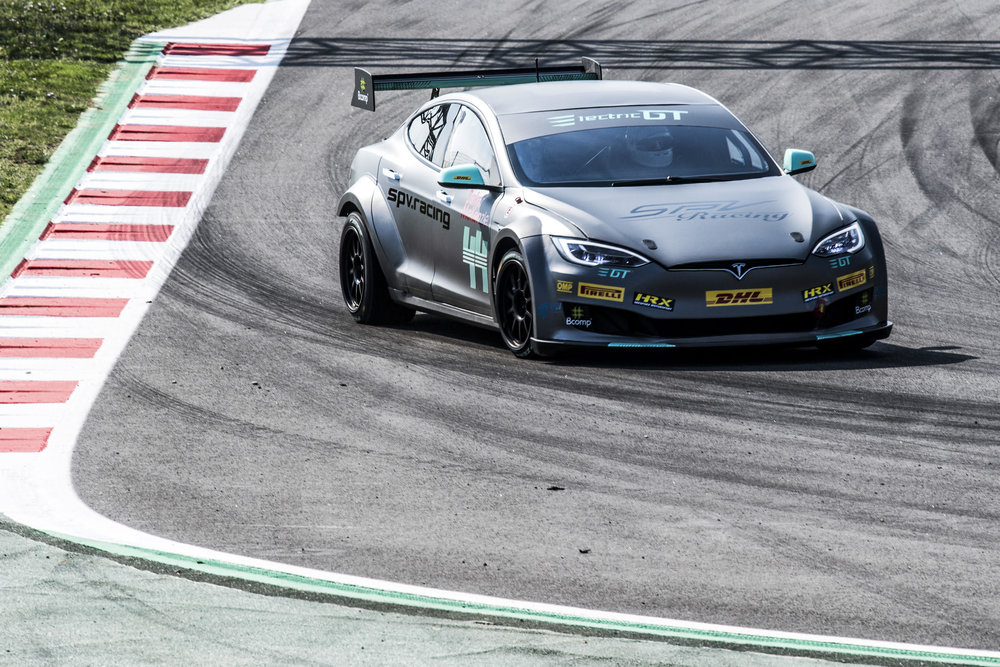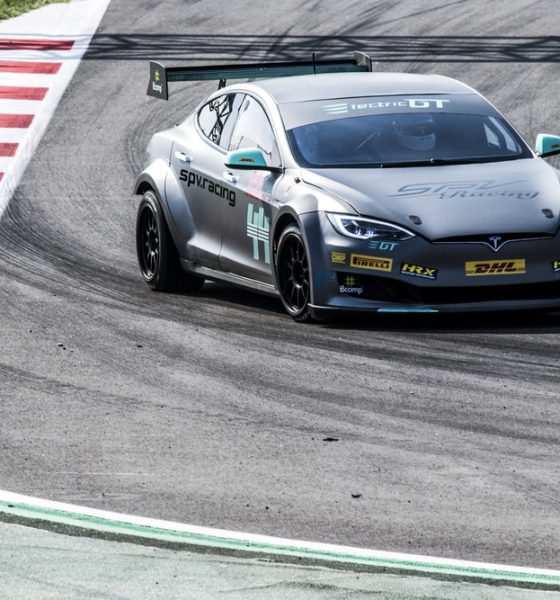

Lifestyle
Electric GT’s Tesla racing series will be a test of driver strategy to avoid overheating
Electric GT, officially known as the Electric Production Car Series, is expected to begin its inaugural season this coming November. Teams of the electric car championship series will be using 10 track-modified Tesla Model S P100D, which are stripped down and fitted with racing components to reduce weight and maximize power. The first track-ready car was showcased recently in a video from auto veteran and former Top Gear and Fifth Gear presenter Tiff Needell, who was able to get behind the wheel of Electric GT’s P100D race car in a test drive around the nearly 2.9-mile Circuit de Barcelona-Catalunya in Barcelona.
While Tiff was impressed by the power and handling of Electric GT’s Model S P100D race car, the vehicle’s limitations immediately became apparent after being driven hard for a lap and a half. After this, the electric car experienced overheating issues, forcing the electric car to stop on the pits to be cooled down. Considering that Electric GT plans to hold 37-mile races for its inaugural season, it would be quite tricky to have vehicles that would only be good for a couple of laps before they overheat.
A spokesperson for Electric GT recently addressed what happened to the P100D race car during Tiff’s test drive. According to the spokesperson, the vehicle had been out in the heat all day before it was driven by the former Top Gear and Fifth Gear host. Engineers from the racing series also noted that some of the car’s sensors did not work properly, allowing the Model S P100D race car’s battery to get hotter than it should have.
“The team spotted an accidental disconnection of one of the outdoor temperature sensors from the air conditioning system, which caused the air conditioning system to not send cold air to the battery and other systems when needed. There is always a limit if the power is used indiscriminately, but the resistance threshold is much higher if the air conditioning system had worked correctly. The team has now fixed that,” the spokesperson said.
Considering the limitations on the Model S P100D race car, the Electric GT spokesperson noted that the vehicle would be able to run the race distances — but with some strings attached. Instead of taking advantage of the race car’s 778 hp all the time, the vehicles would be running at a more manageable 470 hp. The spokesperson further noted that drivers would have full control to decide when to use their P100D race car’s full power, such as when overtaking or dashing to the finish line. This, at least for the inaugural season, would be “part of the strategy and part of the show.”
While using the vehicle’s weakness as a point for strategy is a clever move by Electric GT, the overheating issues of the Model S P100D when driven hard on the track are undeniable. The Model S P100D, after all, is a monster on the drag strip, but it still has teething problems on the track. Fortunately for Tesla’s vehicles, these teething problems do not appear to be present in the Model 3. Over the past months, Model 3s have been taken to the track and driven hard, and not one issue of overheating has emerged from the Tesla community so far. The Model 3 even won the 2018 Canadian Sport Compact Series Time Attack series on its category, and that car was not even the performance version. Nevertheless, the Model 3 Performance, a car that Elon Musk stated is 15% faster on the track than a BMW M3, is set to begin deliveries soon. Once the vehicle saturates the racing market, Electric GT would be wise to adopt the Model 3 Performance as an option for its next racing seasons.
With the Model 3, Tesla is ushering in a new era for its electric cars. The Model 3 might be Tesla’s entry-level vehicle by definition, but its battery tech and electric motors were designed and created at a time when Tesla already had experience in the electric car industry. The Model 3’s 2170 battery cells, for one, are a significant step up from the 18650 cells present in the Model S and Model X. These battery cells are bound to make their way to Tesla’s two flagship vehicles though, most likely in an upcoming and much-speculated Model S and X refresh. If or when this happens, the idea of a Model S track car that can handle events far beyond a 37-mile race would be extremely plausible.

Lifestyle
Tesla Model S Plaid battles China’s 1500 hp monster Nurburgring monster, with surprising results
There is just something about Tesla’s tuning and refinement that makes raw specs seem not as game-changing.

The Tesla Model S Plaid has been around for some time. Today, it is no longer the world’s quickest four-door electric sedan, nor is it the most powerful. As per a recent video from motoring YouTube channel Carwow, however, it seems like the Model S Plaid is still more than a match for some of its newer and more powerful rivals.
The monster from China
The Xiaomi SU7 Ultra is nothing short of a monster. Just like the Model S Plaid, it features three motors. It also has 1,548 hp and 1,770 Nm of torque. It’s All Wheel Drive and weighs a hefty 2,360 kg. The vehicle, which costs just about the equivalent of £55,000, has been recorded setting an insane 7:04.957 at the Nurburgring, surpassing the previous record held by the Porsche Taycan Turbo GT.
For all intents and purposes, the Model S Plaid looked outgunned in Carwow’s test. The Model S Plaid is no slouch with its three motors that produce 1,020 hp and 1,420 Nm of torque. It’s also a bit lighter at 2,190 kg despite its larger size. However, as the Carwow host pointed out, the Model S Plaid holds a 7:25.231 record in the Nurburgring. Compared to the Xiaomi SU7 Ultra’s record, the Model S Plaid’s lap time is notably slower.
Real-world tests
As could be seen in Carwow’s drag races, however, Tesla’s tech wizardry with the Model S Plaid is still hard to beat. The two vehicles competed in nine races, and the older Model S Plaid actually beat its newer, more powerful counterpart from China several times. At one point in the race, the Xiaomi SU7 Ultra hit its power limit due to its battery’s temperature, but the Model S Plaid was still going strong.
The Model S Plaid was first teased five years ago, in September 2020 during Tesla’s Battery Day. Since then, cars like the Lucid Air Sapphire and the Xiaomi SU7 Ultra have been released, surpassing its specs. But just like the Model Y ended up being the better all-rounder compared to the BYD Sealion 7 and the MG IM6, there is just something about Tesla’s tuning and refinement that makes raw specs seem not as game-changing.
Check out Carwow’s Model S Plaid vs Xiaomi SU7 drag race video below.
Lifestyle
500-mile test proves why Tesla Model Y still humiliates rivals in Europe
On paper, the BYD Sealion 7 and MG IM6 promised standout capabilities against the Model Y.

BYD is seeing a lot of momentum in Europe, so much so that mainstream media has taken every opportunity to argue that the Chinese automaker has beaten Tesla in the region. But while BYD sales this year in Europe are rising and Tesla’s registrations remain challenged, the raw capabilities of vehicles like the Model Y are difficult to deny.
This was highlighted in a 500-mile challenge by What Car? magazine, which showed that the new Tesla Model Y is more efficient, cheaper to run, and more reliable than rivals like the BYD Sealion 7, and even the nearly 400 KW-charging MG IM6.
Range and charging promises
On paper, the BYD Sealion 7 and MG IM6 promised standout capabilities against the Model Y. The Sealion 7 had more estimated range and the IM6 promised significantly faster charging. When faced with real-world conditions, however, it was still the Model Y that proved superior.
During the 500-mile test, the BYD nearly failed to reach a charging stop, arriving with less range than its display projected, as noted in a CarUp report. MG fared better, but its charging speeds never reached its promised nearly-400 kW charging speed. Tesla’s Model Y, by comparison, managed energy calculations precisely and arrived at each stop without issue.
Tesla leads in areas that matter
Charging times from 25% to 80% showed that the MG was the fastest at 17 minutes, while Tesla and BYD were close at 28 and 29 minutes, respectively. Overall efficiency and cost told a different story, however. The Model Y consumed 19.4 kWh per 100 km, compared to 22.2 for MG and 23.9 for BYD. Over the full trip, Tesla’s charging costs totaled just £82 thanks to its supercharger network, far below BYD’s £130 and MG’s £119.
What Car? Magazine’s testers concluded that despite BYD’s rapid sales growth and the MG IM6’s seriously impressive charging speeds, Tesla remains the more compelling real-world choice. The Model Y just offers stability, efficiency, and a proven charging infrastructure through its Supercharging network. And as per the magazine’s hosts, the Model Y is even the cheapest car to own among the three that were tested.
Watch What Car? Magazine’s 500-mile test in the video below.
Lifestyle
Tesla Cybertruck slapped with world’s least intimidating ticket, and it’s pure cringe
One cannot help but cringe and feel second-hand embarrassment at the idea of a person just driving around with a stack of these babies.

A Cybertruck parked at Stanford Shopping Center in California was recently hit with what might be the most try-hard piece of paper ever slipped under a wiper blade: a “fake citation” accusing the driver of supporting a “fascist car.”
The note, shared on X by Tesla staff program manager Ryan Torres, quickly made the rounds on X, where it quickly gained attention as an example of how not to protest.
The world’s least intimidating ticket
According to the citation, the supposed “violation” was “driving a fascist car.” The remedial action? Take the bus, call an Uber, or ride a bike. The note also dubbed Elon Musk a “chainsaw-wielding Nazi billionaire.” Now, protests against Tesla and Elon Musk have become commonplace this year, but one cannot help but cringe and feel second-hand embarrassment at the idea of a person just driving around with a stack of fake anti-Tesla/Musk citations.
Torres pointed out the irony himself in his post on X. Tesla currently employs over 140,000 Americans, and SpaceX has put the U.S. firmly back at the top of space technology. As Torres put it, maybe the person behind the world’s least intimidating ticket should “read a book on innovation before vandalizing” other people’s property.
Peak performative clownery
Not to mention that the fake ticket’s logic collapses under its own weight. EVs like the Cybertruck are literally designed to reduce emissions, not “destroy the economy.” If anything, Tesla has bolstered the United States’ economy by fueling jobs in engineering, manufacturing, and clean energy. It’s not the first time a Tesla has been the target of vandalism or politically charged notes, but this one stands out for sheer cringe value.
Torres summed it up neatly: “Peak clownery.” On that point, at least, the citation earns full marks. In a way, though, perhaps cringe fake tickets are not as bad as the literal firebombs that were being thrown at Tesla stores and cars earlier this year because some critics were gleefully misinformed about Elon Musk.








